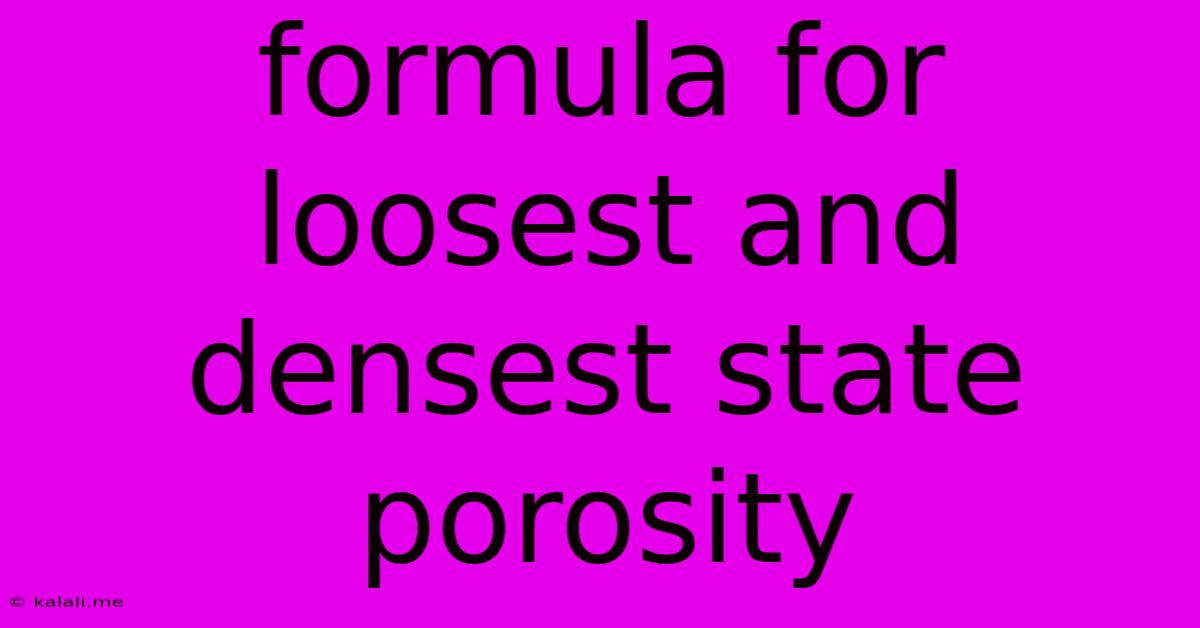Formula For Loosest And Densest State Porosity
Kalali
Jun 11, 2025 · 3 min read

Table of Contents
The Formulas Behind Porosity: Understanding the Loosest and Densest Packing
Porosity, the measure of void spaces within a material, is a crucial property in various fields, including geology, materials science, and civil engineering. Understanding porosity is essential for analyzing rock formations, designing concrete mixes, and predicting the behavior of porous materials. This article delves into the formulas used to calculate the loosest and densest packing arrangements, crucial concepts for determining the upper and lower bounds of porosity. We'll explore how these formulas are derived and applied, providing a comprehensive understanding of this key geological and materials science concept.
What is Porosity?
Porosity (Φ) is defined as the ratio of the volume of voids (V<sub>v</sub>) to the total volume (V<sub>t</sub>) of a material. It's typically expressed as a percentage:
Φ = (V<sub>v</sub> / V<sub>t</sub>) * 100%
This simple formula, however, doesn't account for the arrangement of particles, which significantly impacts the volume of voids. This is where the concepts of loosest and densest packing come into play.
Loosest Packing Arrangement: A Sea of Voids
The loosest packing arrangement represents the maximum possible porosity. Imagine spheres (representing particles) arranged in a way that maximizes the space between them. While there's no single definitive formula for loosest packing, it's conceptually understood as a structure with minimal particle-to-particle contact. The porosity in this arrangement approaches its theoretical maximum. Think of it like stacking oranges loosely in a box—lots of empty space!
The actual porosity value for the loosest arrangement depends heavily on the shape and size distribution of the particles. Irregularly shaped particles will lead to higher porosity compared to perfectly spherical particles. Simulations and experimental measurements are often used to determine the porosity of a specific, loosely packed material.
Densest Packing Arrangement: Minimizing the Voids
The densest packing arrangement represents the minimum possible porosity. This is achieved when the particles are arranged in a way that minimizes the void space. For identical spheres, the densest packing arrangements are well-defined and lead to predictable porosity values. The most common densest packing arrangements are:
-
Cubic Close Packing (CCP) or Face-Centered Cubic (FCC): In this arrangement, the spheres are arranged in a cubic lattice, with spheres occupying the corners and the centers of each face. The porosity (Φ<sub>CCP</sub>) is approximately 26%.
-
Hexagonal Close Packing (HCP): Similar to CCP, HCP involves a hexagonal lattice structure. It achieves the same theoretical maximum density and has a porosity (Φ<sub>HCP</sub>) also approximately 26%.
The porosity calculation for these arrangements is based on the geometric relationship between the sphere diameter and the unit cell volume. While the exact formula derivation can be complex, the result provides a valuable benchmark for understanding the minimum achievable porosity. This is important in diverse applications, such as determining the maximum density achievable in ceramic materials or packing efficiency in industrial processes.
Practical Applications and Considerations
The loosest and densest packing concepts aren't just theoretical exercises; they have significant practical implications:
- Reservoir Engineering: Understanding porosity helps determine the storage capacity of oil and gas reservoirs. The porosity value, combined with permeability, dictates the flow of fluids through the reservoir rock.
- Soil Mechanics: Porosity affects the strength and stability of soil. Higher porosity often means lower strength and higher compressibility.
- Concrete Technology: The porosity of concrete significantly impacts its durability and resistance to freezing and thawing. A lower porosity translates to better durability.
While precise formulas for loosest packing are elusive due to the variability in particle shape and size, the well-defined formulas for densest packing arrangements provide crucial benchmarks for understanding porosity limits. The interplay between particle arrangement, size, and shape significantly influences the overall porosity of a material, highlighting the need for both theoretical understanding and experimental measurements in diverse fields.
Latest Posts
Latest Posts
-
What Number Is Lviii In Roman Numerals
Jun 12, 2025
-
How To Change Octal To Hexadecimal
Jun 12, 2025
-
Reaction Of Calcium Chloride And Water
Jun 12, 2025
-
University Of Alabama Average Sat Score
Jun 12, 2025
-
How Many Different Ways Are There To Save A Document
Jun 12, 2025
Related Post
Thank you for visiting our website which covers about Formula For Loosest And Densest State Porosity . We hope the information provided has been useful to you. Feel free to contact us if you have any questions or need further assistance. See you next time and don't miss to bookmark.